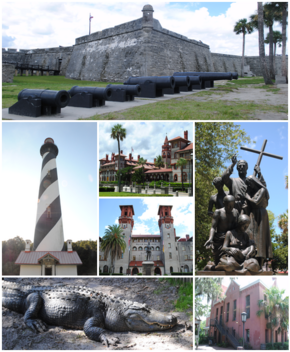Our website is made possible by displaying online advertisements to our visitors.
Please consider supporting us by disabling your ad blocker.
St. Augustine, Florida
St. Augustine
San Agustín (Spanish) | |
|---|---|
 Top, left to right: Castillo de San Marcos, St. Augustine Light, Flagler College, Lightner Museum, statue near the Cathedral Basilica of St. Augustine, St. Augustine Alligator Farm Zoological Park, Old St. Johns County Jail | |
| Nickname(s): Ancient City, Old City | |
 Location in St. Johns County and the U.S. state of Florida | |
| Coordinates: 29°53′41″N 81°18′52″W / 29.89472°N 81.31444°W[1] | |
| Country | United States |
| State | Florida |
| County | St. Johns |
| Established | September 8, 1565 |
| Founded by | Pedro Menéndez de Avilés |
| Named for | Saint Augustine of Hippo |
| Government | |
| • Type | Commissioner-Manager |
| • Mayor | Nancy Sikes-Kline |
| • Vice Mayor | Roxanne Horvath |
| • Commissioners | Barbara Blonder, Cynthia Garris, and Jim Springfield |
| • City Manager | David Birchim |
| • City Clerk | Darlene Galambos |
| Area | |
• City | 12.85 sq mi (33.29 km2) |
| • Land | 9.52 sq mi (24.66 km2) |
| • Water | 3.33 sq mi (8.63 km2) |
| Elevation | 0 ft (0 m) |
| Population (2020) | |
• City | 14,329 |
| • Density | 1,504.99/sq mi (581.05/km2) |
| • Urban | 91,786 |
| Time zone | UTC−5 (EST) |
| • Summer (DST) | UTC−4 (EDT) |
| ZIP code(s) | 32080, 32084, 32085, 32086, 32095, 32082, 32092 |
| Area code(s) | 904, 324 |
| FIPS code | 12-62500[4] |
| GNIS feature ID | 0308101[3] |
| Website | City of St. Augustine |
St. Augustine (/ˈɔːɡəstiːn/ AW-gə-steen; Spanish: San Agustín [san aɣusˈtin]) is a city in and the county seat of St. Johns County, Florida, United States. Located 40 miles (64 km) south of downtown Jacksonville, the city is on the Atlantic coast of northeastern Florida. Founded in 1565 by Spanish colonists, it is the oldest continuously inhabited European-established settlement in what is now the contiguous United States.
St. Augustine was founded on September 8, 1565 by Spanish admiral Pedro Menéndez de Avilés, Florida's first colonial governor. He named the settlement San Agustín, because his ships bearing settlers, troops, and supplies from Spain had first sighted land in Florida eleven days earlier on August 28, the feast day of St. Augustine.[5] The city served as the capital of Spanish Florida for over 200 years. It became the capital of British East Florida when the colony was established in 1763 and continued as the capital when the colony was transferred to Spanish rule twenty years later in the 1783 Treaty of Versailles.
Spain ceded Florida to the United States in 1819, and St. Augustine was designated one of the two alternating capitals of the Florida Territory, the other being Pensacola, upon ratification of the Adams–Onís Treaty in 1821. The Florida National Guard made the city its headquarters that same year. The territorial government moved and made Tallahassee the permanent capital of Florida in 1824.[6]
St. Augustine is part of Florida's First Coast region and the Jacksonville metropolitan area. It had a population of 14,329 at the 2020 census, up from 12,975 at the 2010 census. Since the late 19th century, St. Augustine's distinctive historical character has made the city a tourist attraction. Castillo de San Marcos, the city's 17th-century Spanish fort, continues to attract tourists.[7] St. George Street is a major pedestrian street that runs through the downtown area and includes over 30 historic houses and tourist attractions.[8]
- ^ "GNIS Detail – Saint Augustine". geonames.usgs.gov. Geographic Names Information System. February 12, 2011. Archived from the original on September 11, 2014. Retrieved April 23, 2011.
- ^ "2020 U.S. Gazetteer Files". United States Census Bureau. Retrieved October 31, 2021.
- ^ a b "US Board on Geographic Names". geonames.usgs.gov. United States Geological Survey. October 25, 2007. Archived from the original on February 12, 2012. Retrieved January 31, 2008.
- ^ "U.S. Census website". census.gov. United States Census Bureau. Retrieved January 31, 2008.
- ^ Hennesey, James J. (December 10, 1981). American Catholics: A History of the Roman Catholic Community in the United States: A History of the Roman Catholic Community in the United States. New York: Oxford University Press. p. 11. ISBN 978-0-19-802036-3. Archived from the original on May 3, 2016. Retrieved October 27, 2015.
- ^ Montès, Christian (2014). American Capitals: A Historical Geography. University of Chicago Press. p. 132. ISBN 978-0-226-08051-2.
- ^ Staff (April 10, 2020). "Coquina | The rock that saved St. Augustine)". www.nps.gov. Archived from the original on March 4, 2021. Retrieved December 6, 2022.
- ^ Brooke, Steven (2005). The Majesty of St. Augustine. Pelican Publishing. p. 20. ISBN 978-1-4556-0819-5.
Previous Page Next Page




